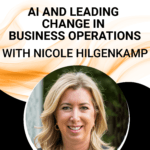
AI and Leading Change in Business Operations with Nicole Hilgenkamp
Why does AI make digital transformation both easier—and infinitely harder?
New technology promises efficiency, automation, and smarter decision-making, but the real challenge isn’t the tools—it’s getting people to embrace them. In this episode of Innovation Tales, transformation expert Nicole Hilgenkamp unpacks why adoption often stalls, how leaders can break through resistance, and what it really takes to make innovation stick. If you’re navigating change in your organization, this conversation is a must-listen.
Key Takeaways
- AI adoption is a people-first challenge: Success in digital transformation depends on employees’ willingness to adapt, not just the technology itself.
- Leadership must drive AI literacy: Business leaders play a critical role in educating teams, providing structured training, and fostering a culture of exploration.
- Data and process readiness are essential: AI can only deliver value when organizations have clean, well-structured data and standardized workflows in place.
The Human Challenge of AI Adoption
Despite the buzz around AI, its implementation often faces a roadblock that has little to do with technology: people. AI can streamline processes, improve efficiency, and provide deeper insights, but if employees don’t trust or understand it, adoption will stall.
AI is transforming business at lightning speed. But technology isn’t the hardest part. Rather, it is people’s ability to keep up and adapt.

Nicole emphasizes that the most successful AI-driven initiatives begin with people. Companies can introduce cutting-edge tools, but if employees don’t grasp the “why” behind the change, resistance will follow. She highlights common fears, including:
- Job displacement—“Will AI replace my role?”
- Privacy concerns—“Is my data safe?”
- Loss of control—“Will AI make decisions for me?”
- Ethical dilemmas—“How do we prevent AI from being misused?”
Overcoming these fears requires clear communication, structured learning opportunities, and leadership that models AI adoption in a positive and transparent way.
Building AI Literacy: A Leadership Imperative
One of the most effective ways to counter AI resistance is by improving AI literacy across the organization. Leaders play a key role in this by educating their teams and fostering a culture of experimentation. Nicole breaks down the process into three key steps:
Let’s just say you have a team of a hundred people. Some of those hundred people are already utilizing artificial intelligence in their personal lives and even in their professional lives. They’re just not telling you.
- Model AI adoption: Leaders should demonstrate how AI can be used to enhance work, from drafting reports to automating administrative tasks.
- Provide training and guardrails: Employees need foundational AI knowledge, including what AI can and cannot do, how to use it responsibly, and the risks involved.
- Encourage exploration: Teams should be given the freedom to test AI tools in low-risk environments, discovering use cases that improve their workflows.
By taking this approach, organizations can create a workforce that sees AI as an enabler rather than a threat.
AI Use Cases for Non-Technical Teams
Many AI adoption efforts focus on technical teams, but AI’s true potential lies in how it enhances everyday tasks for non-technical users. Nicole highlights how AI can help:
It is your coach, your teacher, your tutor, your psychologist, your tax, your tax advisor. You can use it for so much.
- Automate repetitive processes, freeing up time for higher-value work.
- Enhance customer interactions through AI-powered insights and responses.
- Generate data-driven reports, reducing manual effort.
- Personalize internal training and development programs.
Importantly, she stresses that AI adoption should be a team effort. When employees collaborate on AI use cases and share successful applications, the organization as a whole benefits.
The Role of Data and Process in Digital Transformation
While AI can amplify efficiency, it relies on high-quality data and standardized processes. Many organizations struggle with digital transformation not because of the AI itself, but due to underlying issues in their operational foundations. Nicole points to two critical areas:
If your data’s not prepared to be that input, if you have duplicate records, if you have not maintained your records that you’re going to use as those inputs in the technology that you’re using, AI being one of them, then that’s going to affect the results you get out of that technology or out of that artificial intelligence.
- Data readiness: AI is only as good as the data it processes. Inaccurate, incomplete, or siloed data can severely limit AI’s effectiveness.
- Process standardization: Organizations often attempt to fit AI into existing, fragmented processes rather than streamlining workflows first. AI works best when applied to well-defined, optimized operations.
Businesses that address these challenges before scaling AI initiatives see much higher returns on investment.
The Next Phase: AI-Driven Automation
AI literacy and adoption are just the first steps. The real transformation begins when organizations move from AI-assisted tasks to full automation. However, Nicole warns that many companies overestimate how quickly they can achieve AI-powered efficiency.
You’re not getting that a 30 percent return on investment. You’re getting a 3 percent return on investment for the reasons that I’m talking about.
AI can immediately help employees work smarter—generating content, summarizing reports, or automating small tasks. But for AI to deliver its full promise, companies must invest in automation at scale. This means:
- Cleaning and unifying data sources to support AI-driven automation.
- Redesigning workflows to integrate AI into standard operating procedures.
- Prioritizing high-impact automation projects rather than scattered, low-value efforts.
Without this strategic approach, AI projects risk stalling out after initial excitement fades.
Looking Ahead: The Future of AI in Business Operations
AI’s rapid advancement means organizations must continuously adapt. Nicole predicts that the businesses best positioned for the future will be those that:
Because AI, as one of those transformation options, is moving so fast, you’re getting further behind.
- Invest in AI literacy at all levels.
- Prioritize data governance and process improvement.
- Adopt a strategic, phased approach to automation.
- Emphasize human-AI collaboration rather than full replacement.
As AI continues to evolve, companies that integrate it thoughtfully into their operations will gain a competitive edge—improving efficiency, boosting employee engagement, and driving innovation.
Conclusion
AI is transforming business operations, but its success hinges on more than just technology—it requires people, leadership, and strategic readiness. As Nicole Hilgenkamp highlighted, AI adoption is most effective when organizations prioritize employee engagement, invest in AI literacy, and ensure data and processes are optimized for automation. By taking a structured, human-centered approach, businesses can harness AI’s potential to drive efficiency, enhance decision-making, and foster a culture of continuous innovation.
Take the Next Step
Ready to make AI a strategic advantage for your organization? At Aibration, we specialize in equipping teams with the knowledge and tools they need to seamlessly integrate AI into their workflows. Our coaching and training sessions are designed to enhance digital literacy, optimize business processes, and empower leaders to drive AI-led transformation. Book a personalized AI training session today and take the lead in the future of intelligent business operations.
Join the Conversation
How is your organization approaching AI adoption, and what challenges have you faced in getting teams on board? Share your insights and experiences with us on Innovation Tales’ LinkedIn page—let’s continue the discussion! And don’t forget to register for the upcoming live webinar: AI Agents for Business!
Further Reading
- Superagency by Reid Hoffman – A thought-provoking look at how AI can empower businesses and individuals.

Episode timeline:
- 00:00 Introduction: The Real Challenge of Digital Transformation
- 00:00 Meet Nicole Hilgenkamp: Transformation Expert
- 00:00 Embracing AI: Overcoming Fear and Resistance
- 00:00 AI Literacy: Enabling Your Team
- 00:00 Identifying AI Use Cases for Non-Technical Teams
- 00:00 Data and Process: The Backbone of Digital Transformation
- 00:00 The Future of AI in Business Operations
- 00:00 Practical Advice for Leaders
- 00:00 Conclusion: Preparing for Continuous Change





